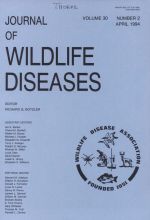A method to determine erythrocyte cholinesterase (ChE) activity was modified for use in wild mammals. Erythrocyte ChE of California voles (Microtus californicus) was primarily acetylcholinesterase (AChE), which was similar to the brain and unlike plasma which was primarily butyrylcholinesterase (BChE). Triplicate erythrocyte AChE analyses from individual animals of several species of wild rodents revealed a mean coefficient of variation of 8.7% (SD = 4.3%). Erythrocyte ChE activity of several wild mammals of California revealed that mule deer (Odocoileus hemionus) had the highest erythrocyte AChE activity (1,514.5 mU/ml) and dusky-footed woodrats (Neotoma fuscipes) had the lowest activity (524.3 mU/ml). No ChE activity was found in erythrocytes of several species of birds and fish.
How to translate text using browser tools
1 April 1994
MODIFICATIONS OF A CHOLINESTERASE METHOD FOR DETERMINATION OF ERYTHROCYTE CHOLINESTERASE ACTIVITY IN WILD MAMMALS
Deborah A. Donovan,
Joseph G. Zinkl

Journal of Wildlife Diseases
Vol. 30 • No. 2
April 1994
Vol. 30 • No. 2
April 1994
acetylcholinesterase
brain
butyrylcholinesterase
California voles
deer mice
erythrocyte
plasma




